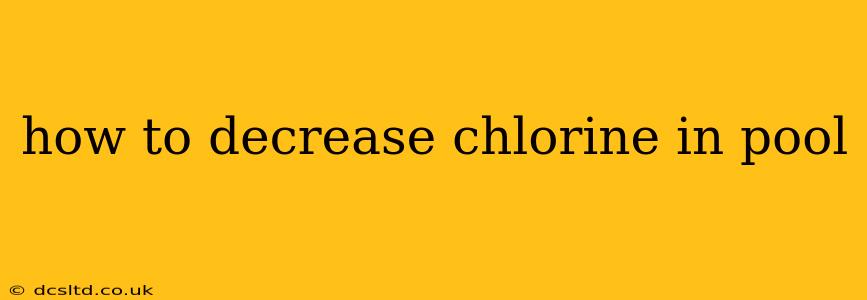Maintaining the proper chlorine levels in your swimming pool is crucial for both swimmer safety and the longevity of your pool equipment. Too much chlorine, however, can lead to irritated eyes, skin, and even damage your pool's finish. This guide will walk you through the safe and effective methods for lowering chlorine levels in your pool.
Why is my pool chlorine too high?
Before diving into solutions, let's understand why you might have excessively high chlorine levels. Several factors can contribute:
- Over-addition: Accidentally adding too much chlorine is a common culprit. Always follow the instructions on your chlorine product carefully.
- Strong sunlight: UV rays from the sun can break down chlorine, releasing chloramines (combined chlorine) which can then oxidize back into free chlorine, causing a sudden spike.
- Inadequate circulation: Poor water circulation prevents even distribution of chlorine, leading to localized high concentrations.
- Improper testing: Inaccurate test readings can result in unnecessary additions of chlorine. Always double-check your test results.
How to test your pool chlorine levels?
Accurate testing is the first step. Use a reliable test kit (liquid test kits are generally more accurate than test strips) to measure your free chlorine and total chlorine levels. The ideal free chlorine range is typically between 1 and 3 parts per million (ppm).
How do I lower chlorine levels in my pool?
Several methods can effectively lower high chlorine levels in your pool. The best approach depends on how significantly the levels exceed the ideal range.
1. Dilution with Fresh Water
For only slightly elevated chlorine levels, adding fresh water can dilute the concentration. This method is the simplest but requires a substantial amount of water, depending on your pool's size and the chlorine level.
2. Running the Pool Pump
Ensure your pump is running for the recommended duration to ensure proper water circulation and filtration. This helps distribute the chlorine more evenly and can help reduce the concentration over time.
3. Partial Water Drain and Refilling
If chlorine levels are significantly high, draining a portion of your pool water and refilling with fresh water is a more effective solution. This method is more labor-intensive and requires careful planning. Remember to follow local regulations concerning water usage and disposal.
4. Using a Chlorine Neutralizer (Pool Shock)
This might sound counterintuitive, but certain types of "pool shock" (specifically those containing sodium thiosulfate) can actually neutralize excess chlorine. However, use this method carefully and precisely as directed by the product's instructions. Always double-check the product label to ensure it's designed for chlorine reduction.
What is a chlorine neutralizer?
A chlorine neutralizer is a chemical, typically sodium thiosulfate, added to the pool to reduce free chlorine levels. It chemically reacts with the chlorine, rendering it harmless. It is crucial to follow the product instructions meticulously to avoid any accidental imbalances in your pool's chemistry.
How long does it take to lower chlorine levels?
The time it takes to lower chlorine levels depends on the chosen method and the severity of the overchlorination. Adding fresh water might take a few hours to show noticeable results. Using a neutralizer typically offers quicker results, while draining and refilling requires the longest time frame.
What are the signs of too much chlorine in a pool?
High chlorine levels present several noticeable signs:
- Strong chlorine smell: A pungent, irritating smell is a clear indication of excess chlorine.
- Irritation: Swimmers experience burning eyes, skin irritation, and coughing.
- Faded pool surfaces: High chlorine can damage the pool's finish over time, causing discoloration and fading.
Can I swim in a pool with high chlorine?
While short exposure might not cause severe harm, prolonged exposure to high chlorine levels is strongly discouraged. It's best to wait until the chlorine levels are within the safe range before swimming again.
This guide offers several safe and effective ways to reduce high chlorine levels in your pool. Remember to always prioritize safety and follow instructions carefully when handling pool chemicals. If you are unsure about any aspect of pool maintenance, consult a pool professional.
